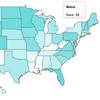Paper rolls
The pulp and paper industry has been taking it on the chin this winter, scrambling to gain its footing in a wobbly global market. Reduced demand and falling prices have led to multiple furloughs at mills across the state, the permanent closure of Wausau in Jay expected by May 31, and the indefinite shutdown starting in May of Domtar in Baileyville. Other mills have cut staff and idled machines until the economy rebounds.
The chill will likely temper what’s been a sustained increase in exports for the industry over the last 10 years, according to John Williams, president of the Maine Pulp and Paper Association. A presentation by Janine Bisaillon-Cary, president of the Maine International Trade Center, at the annual Paper Days conference at the University of Maine in Orono earlier this month showed Maine’s forest-based products are still king of the export hill. In 2008, pulp, paper and wood products totaled $870 million in sales, representing nearly 30% of Maine’s exported goods and outpacing the No. 2 industry — electronic parts — by more than $21 million. Last year’s numbers capped a 10-year, steady increase in pulp and paper sales. Pulp exports have risen 147% since 1999, while paper rose 64% over the same period. Increased sales have recently gone to Europe, China and Brazil.
But the shutdown of Domtar, which produces 1,000 tons of pulp per day, primarily for foreign markets, will significantly affect export numbers next year unless the market rebounds, said Williams. Part of last year’s export performance of pulp was tied to an increase in sales to South Korea, which were up to that country 23% over 2007. Bisaillon-Cary attributed part of the spike to a weak U. S. dollar through the first half of 2008, when pulp exports to South Korea rose by 60% over 2007. Then the financial turmoil that clobbered the United States spread globally.
“Korea was hit hard by the financial crisis and the won weakened against the dollar,” she said. “Once the markets stabilize, I expect [the demand for Maine pulp] will go up again.”
She said Korea has been doing a lot of value-added processing of pulp into paper and paperboard that is then shipped throughout Asia. The price for pulp will be key in the industry’s recovery, said Williams. In general numbers, Maine pulp that sold for $700-$800 per short ton last year now sells for $400.
Keith Van Scotter, president of Lincoln Paper and Tissue and a luncheon speaker at Paper Days, said colleagues have told him they expect 2009 will be the worst year ever as the industry braces for “an unprecedented reduction in demand.” Some analysts predict reductions of between 20% and 30% in demand for coated free sheet, uncoated free sheet and coated groundwood. And while the industry has survived previous recessions, Van Scotter said this one differs in that its customers are ailing. Previous downturns can be attributed to “self-inflicted” trends within the industry, such as over building mills and creating excess capacity, he said.
“Newspapers and magazines pulled down hefty margins in previous downturns, but this is different,” he said, pointing out that some catalogers, printers and newspapers are in bankruptcy now.
Still, there was cause for optimism at the conference. Williams emphasized that Maine’s mills are poised for a rebound and can easily step up production to meet increased demand. Investments in productivity mean Maine mills can compete in quality and price in a global market. The tons of paper produced per worker per year in Maine has risen from about 250 tons in 1998 to more than 450 tons today, he said.
“We believe exports will continue to grow [once the market stabilizes],” said Williams. “Then we can pick up where we left off.”
Carol Coultas, Mainebiz editor, can be reached at ccoultas@mainebiz.biz.










Comments